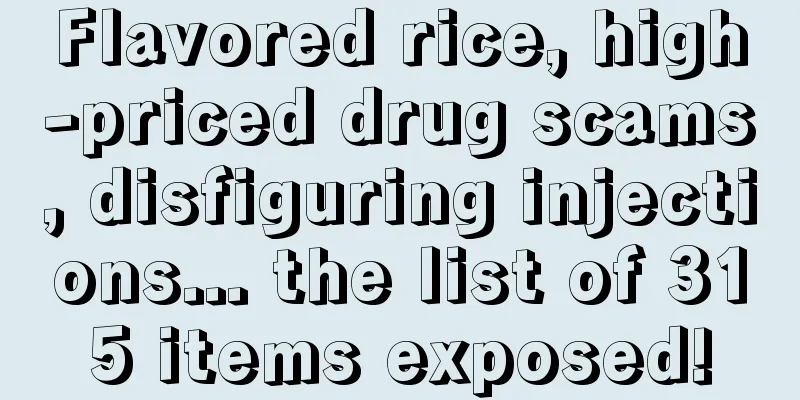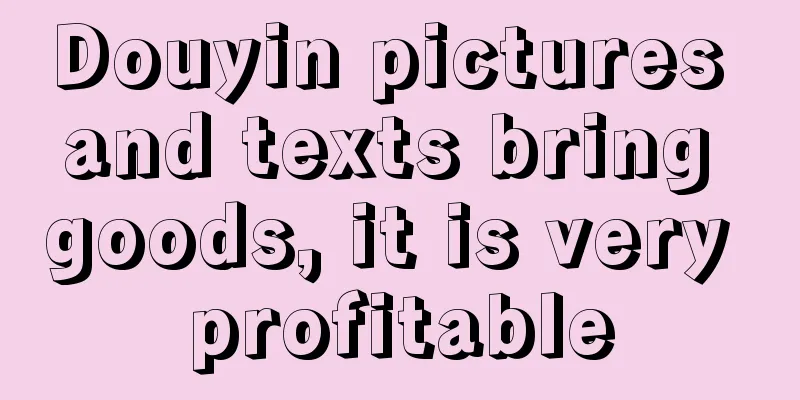Flavored rice, high-priced drug scams, disfiguring injections... the list of 315 items exposed!

It’s March 15 (International Consumer Rights Day) again this year. It is a good day for consumers to watch the show, but it is a "big test" for enterprises. Every year, a number of illegal and irregular enterprises are "hit", and one exposure may cause the brand influence and credibility that have been worked hard for many years to vanish overnight. When facing a public relations crisis, companies have different attitudes and ways of dealing with it, and the final outcomes are also different . When a crisis comes, how should companies respond? We can get a glimpse of the key from numerous cases. 1. Who is on the 315 list this year?1. “Fake” Thai riceThe first shot fired at the 315 Gala was Thai fragrant rice. The Thai fragrant rice in your hand may just be ordinary rice mixed with essence. The reporter secretly visited Shouxian Yongliang Grain and Oil Food Co., Ltd. in Shouxian County, Anhui Province. The "Thai King" second-generation Thai fragrant rice produced by this company actually has nothing to do with Thailand. "Thai King" is just a registered trademark. It is reported that "just add a few drops of essence to the rice and the local rice will smell like Thai fragrant rice", and more than 1,000 tons of such rice can be sold a year. 2. Non-injectable cosmetic needlesThe 315 Gala also exposed the chaos in the medical beauty industry. Reporters found that many facial beauty injection products were not even registered as cosmetics. The prices of cosmetic injections are not transparent, but the profits can be as high as 10 times. At the same time, many medical beauty hospitals do not have medical licenses but are performing illegal injections. 3. Substandard helmetsAt this 315 Gala, several motorcycle helmets with good sales on the market were randomly selected for performance testing. The results showed that the quality of most helmets did not meet the requirements of the new national standards, and consumers felt like wearing razor blades on their heads. 4. The middle game of the sad dramaThis is a new type of fraud targeting the elderly. The scammers fabricate tragic dramas using scripts and play the role of kind-hearted people or good sons to attract the elderly to watch. After gaining the trust of the elderly, these fraudulent anchors began selling "health products", but in fact, most of these so-called health products are extremely low-cost solid beverages, compressed candies, etc. 5. Radio lecture scamSome scammers sell fake health foods to the elderly by giving away free storytelling machines, tapes that play made-up "expert" statements, and false efficacy advertisements. 6. ETC card disabled text message scamThis is a new type of "phishing", where criminals trick consumers into logging into phishing websites by saying "ETC cards are disabled" and other reasons. Once consumers log in, their accounts are deducted by the scammers without them noticing. 7. The online shopping trollsThe 315 Gala also exposed a big "secret" of the live broadcast industry. The popularity of the live broadcast room you see is likely to be fake. In the cloud control room, a computer can control hundreds or thousands of mobile phones at the same time to act as water army. The staff said: There is a huge demand for water army every day. 8. Restoring to factory settings is not safeTests show that one-click deletion, formatting, and factory reset cannot completely delete data. Technicians can restore the originally deleted data one by one. Therefore, we need to check all storage items when restoring the factory settings so that the personal information in the phone will be safely deleted. 9. Unsafe seat beltsThe three-point safety belts used in the high-altitude projects of a certain scenic spot were revealed to be unsafe. After a fall, it is easy to break a person's ribs. During rescue, it is also easy to fall off again. Therefore, the five-point safety belt is safer. 9. Used insulators are put back on the marketInsulators are one of the important guarantees for the safe operation of power lines and play a very critical insulating role. However, in Yunnan, Guizhou, Sichuan, Shaanxi and other places, many factories refurbish and paint discarded insulators and sell them again without testing. 10. Cracked APP becomes a bugIn order to save money, some consumers will choose to download various cracked versions of APPs online, but they don’t know that such operation is like installing a surveillance device on their mobile phone. Investigators found that a cracked version of the APP would embed three third-party plug-ins that had nothing to do with the official ones. These plug-ins could steal user personal information and even conduct eavesdropping. 11. Poor quality cement pipes pose hidden dangersIn the construction of high-standard farmland, culverts are key facilities for water diversion, irrigation, drainage and flood control, and reinforced concrete cement pipes are the core components of culverts. However, most of the cement pipes at the high-standard farmland construction site in Binhai County are exposed and have serious damage problems. Not only the companies involved in the incident exposed last night, but also many companies with "problems" have been trending in recent days. For example, the "farmed shrimps sold as wild shrimps" incident recently exposed by Oriental Selection, the CEO also came out to respond positively last night. As for the safety belt problem in scenic spots exposed on March 15, the scenic spots mentioned responded that they were not considering rectification for the time being. In terms of the two ways of handling crisis public relations, the former is obviously more prudent than the latter. If crisis public relations is done well, it is possible to reduce a major incident to a minor one and turn danger into safety. However, any act of neglect or improper handling may "add fuel to the fire" and damage the relationship between the company and consumers. 2. The “negative example” of crisis public relationsWhen facing crisis public relations, I believe that most brands are thinking about how to come up with a response plan as soon as possible and considering how to restore their reputation. However, there are still many brands that do not repent when faced with mistakes and do not take consumers into consideration at all. In the end, they "ruin" themselves and become a negative example of crisis public relations. On November 17, 2018, the well-known Italian clothing brand D&G released a promotional video on social media with the title "Pick up your chopsticks and eat." The content of the promotional video involves the combination of Italian culture and traditional Chinese culture, but the way the actors use chopsticks, the lines and tone of the narration in the film have led many netizens to question whether the brand is discriminating against China. Image source: D&G promotional film As soon as the promotional video was released, it set off a wave of public opinion on social media. Faced with the crisis, D&G officials did not make a positive response to the matter, but quietly deleted the video on the Weibo platform. But careful netizens discovered that this video still exists on mainstream foreign social media such as Instagram and Facebook. This hypocritical behavior has further aggravated the dissatisfaction and condemnation of the Chinese people. In the face of the public relations crisis, D&G's handling method was undoubtedly "arrogant". Its chief designer openly responded to netizens on social software and made insulting remarks about China. After the screenshots were exposed, he denied it on the grounds that his account was stolen. As a result, the Chinese people, who were completely annoyed, began to boycott the D&G brand online, and many e-commerce apps also announced that they would remove related products from their shelves. Even the Central Committee of the Communist Youth League criticized it by name. At this time, D&G officials finally woke up from their dreams and released an apology video, but it was too late. Looking back at the entire incident, we found that whether in terms of quick response, sincere attitude or assumption of responsibility, D&G showed an attitude of refusing to repent and shirking its responsibilities. While all Chinese consumers were waiting for an apology and handling of the matter, D&G made one mistake after another and eventually became an insulting brand in China and was spurned by consumers. Not just D&G, I have summarized the brands that have committed suicide in crisis public relations into several categories of "wrong" behaviors:
So when a company encounters a public relations crisis, what is the correct way to deal with it? 3. How can enterprises correctly deal with crisis public relations?Whether it is 315 or daily complaints and exposure, brands need to prepare crisis public relations handling mechanisms in advance. The following points are summarized for reference: 1. Quick response: Take the initiativeIn the Internet age, all information can ferment rapidly in a very short time. Therefore, after a crisis occurs, the company should activate the emergency plan as soon as possible and communicate with the media and the public based on the principle of "speed first". It must not delay and miss the best window for dealing with the crisis. In 2012, CCTV's 315 Gala exposed McDonald's Beijing Sanlitun store for selling expired food and arbitrarily changing the shelf life of food. This was a major crisis for the McDonald's brand after entering China. However, just one and a half hours after the incident, McDonald's China quickly apologized to the public through Weibo and took a series of measures to resolve the issue. McDonald’s quick response won the initiative for the brand and also gained the understanding of consumers and the public as quickly as possible. On the other hand, those companies that simply procrastinate and evade after problems arise not only lose the precious window of opportunity to establish a responsible corporate image, but also allow their corporate credibility to be constantly eroded by speculation and suspicion from the public. In this battle to protect their corporate brands, they have lost from the very beginning. 2. Sincerity: the most effective way to dispel rumorsWhen a crisis occurs, all deception and concealment will lead to serious consequences. Enterprises should correct their positions, not avoid problems, communicate with the masses with a sincere attitude, and promptly explain the progress of the incident to the outside world to regain the trust of the masses. Regarding this point, Haidilao has given us a good example. In 2011, Haidilao was exposed for problems such as mixing bone broth and not weighing products, which caused a social uproar. As soon as the incident happened, Haidilao officially issued an apology statement with a sincere tone, admitting the fact of mixing and other problems, and thanking the media for supervision. This Weibo post was forwarded 1,809 times and commented on 690 times, indicating that users have basically accepted Haidilao's attitude. Subsequently, a Weibo post by Zhang Yong, the head of Haidilao, won Haidilao back a lot of points. In his Weibo post, Zhang Yong not only sincerely admitted his mistake, but also gave a specific solution. In the comment section, many netizens expressed their understanding and recognition of Zhang Yong, and said that they were still willing to go to the store to consume. So far, Haidilao's crisis has basically come to an end. In my opinion, Haidilao's performance in this crisis is classic. It responded quickly, took the initiative to admit mistakes, and did not evade or shirk responsibility. The management team was brave enough to take responsibility and came up with solutions, such as strengthening the internal supervision mechanism and closing the stores involved for rectification. This approach greatly calmed the public emotionally and gave consumers and the media an explanation. After the storm passed, Haidilao's business was still booming. 3. Authoritative confirmation: using a third party to speak for youAfter a crisis occurs, it is difficult for a company to win the trust of the public simply by making statements on its own behalf. In order to enhance the authority and fairness of incident handling, companies in crisis need to introduce a third-party authoritative agency at the appropriate time, which will give convincing conclusions and help companies resolve the crisis more quickly. In 2016, CCTV reported that Xiabu Xiabu was using cheap pig blood to impersonate duck blood. It is reported that cheap pig blood contains a high concentration of formaldehyde, which is harmful to health if consumed for a long time. Once the exposure came out, it caused panic among consumers. Facing the crisis, Xiabu Xiabu released a statement on Weibo that evening, stating that the company attached great importance to the incident. It also announced that it would stop selling duck blood from that day on and cooperate with relevant departments, media and testing agencies to conduct an investigation. Xiabu Xiabu is well aware that when a crisis occurs, people's trust in the brand will be severely compromised. If it firmly states that there is no problem with its own products at this time, it will not only fail to help resolve the crisis, but may easily have a counterproductive effect. Therefore, it is a more convincing method to bring in an authoritative "third party" to conduct quality inspections and convince consumers with the results. As the test results came out, the public realized that this was a misunderstanding. After being able to clarify the matter, Xiabu Xiabu announced that duck blood would continue to be sold, and also cleverly took advantage of the opportunity for marketing - launching a "Free Tasting of Safe Duck Blood" campaign, where consumers who spend any amount in the store would receive a plate of duck blood for free. It is reported that after the "duck blood blunder", Xiabu Xiabu's revenue increased by 30% that year . So far, the crisis ended with Xiabu Xiabu's crisis public relations victory. You see, in fact, crisis is not necessarily a bad thing. If handled properly, it can add points to the company. Not only can it turn a crisis into a safe situation, but it can even turn a crisis into an opportunity for the company's development, win the trust of consumers, and lead to an increase in product sales. 4. Final ThoughtsIn short, it is difficult for a company to guarantee that no problems will arise during its development process, especially now that various platforms and media are developing rapidly, and every move of a company may be infinitely magnified. But when a crisis really occurs, companies should adjust their mentality and actively face and solve it. Remember that a crisis is not a disaster, and we should be good at finding opportunities in crises and turning crises into opportunities. Author: Yan Tao; Editor: Chief Source: WeChat public account "Yan Tao Sanshou (ID: yantao-219)" |
>>: Heytea goes overseas and copies the next Mixue Ice City
Recommend
If your boss doesn’t understand data, are you still data-driven?
Regardless of the industry, data-driven work has b...
The crossroads of the 100 billion short drama: iQiyi, Youku and Tencent Video face off against ByteDance
With the rise of short videos, the short drama mar...
How does Jiaoxia expand its product categories? You can learn from Xiaohongshu’s successful experience
The Jiaoxia brand is a rising star that focuses on...
What are the basic knowledge about Alibaba International Station? Introduction to basic knowledge
If you want to do Alibaba International Station, y...
What is the conversion rate of an independent website? How to improve it?
Merchants who run independent websites need to pay...
Does Amazon require promotion fees? What are the procurement costs?
Merchants who open stores online know that traffic...
Learn about games: design marketing mechanisms that make users addicted!
There are many people who like to play games. Game...
Having learned the essence of Zhou Hongyi, who will take over the traffic of the leaking Maybach?
The car owner's rights protection has attracte...
Shopee Official Wallet January Advertising Gold Activity Description
Shopee Official Wallet Advertising Bonus Incentive...
How to set up Amazon advertising? Detailed steps
Whether it is Taobao, JD.com, Pinduoduo, or Amazon...
What should I do if my Meikeduo store is closed? How should I choose products?
After you open a store on the Meikeduo platform, i...
The popular short drama on Douyin was finally taken down by Pinduoduo
In the short play, Pinduoduo still follows the log...
How often is Amazon ODR updated? How much can Amazon ODR not exceed?
Amazon ODR must not exceed the standard. If the OD...
Are you always self-satisfied at work or starting a business? You need to think like this
Being criticized in the workplace, a product not b...
2 million fans, monthly GMV exceeds 50 million, the "new king" of the food broadcasting industry has emerged
This article explores the development potential an...





![The public account [Content Boost] is in internal testing, and the traffic is coming!](/upload/images/67e6ef0eca773.webp)



